Dynamic Mission Planning Framework for Collaborative Underwater Operations Using Behavior Trees
Abstract
1. Introduction
- We propose a modular behavior tree-based framework that enables seamless end-to-end mission planning (launch, execution, retrieval, and dynamic docking) for cooperative operations between a moving mothership and an AUV in dynamic marine environments.
- Each mission phase is implemented as an independent sub-tree, allowing for robust error handling and smooth phase transitions.
- Standard localization and obstacle avoidance methods (EKF and FLS-PF) are integrated as modular components, ensuring future extensibility with minimal redesign.
- The proposed system is validated in realistic simulation scenarios (ROS, Stonefish), demonstrating reliable performance and resilience in the presence of communication delays, sensor noise, and injected faults.
2. Overview of Behavior Trees and Application
2.1. Concept of Behavior Trees
2.2. Basic Node Types
3. Methodology
3.1. Proposed Behavior Tree Structure
- Prepare and launch: After deployment is initiated, the AUV separates from the mothership while maintaining a designated safe distance to prevent collision. During this phase, the AUV descends to its target depth and conducts initial system checks, including sensor diagnostics and thruster functionality. The AUV continuously monitors the relative speed and position of the moving mothership, adjusting its maneuvers accordingly to ensure a stable and controlled departure.
- Execute mission: Upon successful launch and initialization, the AUV sequentially visits multiple mission waypoints, which are indicated as yellow markers in the scenario. At each waypoint, the AUV performs various tasks, including seabed mapping, acquiring photographic data, and avoiding obstacles. Throughout this phase, the system is designed to be robust against unexpected events. Suppose anomalies such as sensor faults or communication losses are detected. In that case, the behavior tree promptly activates a dedicated safety node, enabling the AUV to reroute, temporarily suspend its mission, or initiate retrieval actions to ensure operational safety.
- Retrieval and docking: Once all waypoint tasks are completed, the AUV navigates toward the moving mothership to initiate the retrieval sequence. The AUV aligns its trajectory and speed to match those of the mothership, approaches the designated retrieval zone, and carries out docking or ingress maneuvers. The process continues until the AUV is securely recovered within the mothership, marking the end of the mission cycle.
3.1.1. Launch Preparation
3.1.2. Mission Execution
3.1.3. Retrieval and Docking
3.2. Pose Estimation with an EKF
3.2.1. Prediction
3.2.2. Measurement Update
3.3. Obstacle Avoidance Using FLS-Based Potential Fields
4. Simulation
4.1. Simulation Setup
4.2. Results
4.2.1. Scenario 1: Mission Success Under Nominal Conditions
4.2.2. Scenario 2: Fault Response and Exception Handling
4.3. Discussion
5. Conclusions
Author Contributions
Funding
Data Availability Statement
Conflicts of Interest
Appendix A. Sensor and Actuator Specifications
Appendix A.1. AUV Platform
- IMU (Inertial Measurement Unit): 3-axis gyro and accelerometer, angular rate noise: 0.02 rad/s, acceleration noise: 0.05 m/s2
- Depth Sensor: Pressure-based depth estimation, accuracy: ±0.1 m
- DVL (Doppler Velocity Log): Measures body-frame velocity, accuracy: ±0.2 m/s
- USBL (Acoustic Positioning): Provides global position estimate, accuracy: ±2.0 m
- Camera (for docking): Monochrome 2D vision, resolution: 640 × 480 px
- Thrusters: 6-DOF vectored configuration, max thrust per axis: ±30 N
Appendix A.2. Mothership Platform
- USBL Transmitter: Assumed equivalent to AUV receiver, accuracy: ±2.0 m
- Docking Lights: 4-point LED pattern, visible range: 10–15 m
- Propulsion and Control: Dual rudder and horizontal plane for heading and depth adjustment
References
- Nicholson, J.; Healey, A. The present state of autonomous underwater vehicle (AUV) applications and technologies. Mar. Technol. Soc. J. 2008, 42, 44–51. [Google Scholar] [CrossRef]
- Zhang, J.; Han, G.; Sha, J.; Qian, Y.; Liu, J. AUV-assisted subsea exploration method in 6G enabled deep ocean based on a cooperative pac-men mechanism. IEEE Trans. Intell. Transp. Syst. 2021, 23, 1649–1660. [Google Scholar] [CrossRef]
- Jones, D.; Gates, A.; Huvenne, V.; Phillips, A.; Bett, B. Autonomous marine environmental monitoring: Application in decommissioned oil fields. Sci. Total. Environ. 2019, 668, 835–853. [Google Scholar] [CrossRef] [PubMed]
- Wang, C.; Cheng, C.; Yang, D.; Pan, G.; Zhang, F. AUV planning and calibration method considering concealment in uncertain environments. Front. Mar. Sci. 2023, 10, 1228306. [Google Scholar] [CrossRef]
- Zhang, Y.; Wang, Q.; Shen, Y.; Dai, N.; He, B. Multi-AUV cooperative control and autonomous obstacle avoidance study. Ocean. Eng. 2024, 304, 117634. [Google Scholar] [CrossRef]
- Sprague, C.; Özkahraman, Ö.; Munafo, A.; Marlow, R.; Phillips, A.; Ögren, P. Improving the modularity of AUV control systems using behavior trees. In Proceedings of the 2018 IEEE/OES Autonomous Underwater Vehicle Workshop (AUV), Porto, Portugal, 6–9 November 2018; IEEE: Piscataway, NJ, USA, 2018; pp. 1–6. [Google Scholar]
- Szczotka, M. AUV launch & retrieval handling simulation on a rough sea. Ocean Eng. 2022, 246, 110509. [Google Scholar]
- Yan, Z.; Gong, P.; Zhang, W. Dynamic docking technology between AUV and mobile mothership. In Proceedings of the 2020 Chinese Control and Decision Conference (CCDC), Hefei, China, 22–24 August 2020; IEEE: Piscataway, NJ, USA, 2020; pp. 3045–3049. [Google Scholar]
- Chen, Y.; Guo, X.; Luo, G.; Liu, G. A formation control method for AUV group under communication delay. Front. Bioeng. Biotechnol. 2022, 10, 848641. [Google Scholar] [CrossRef] [PubMed]
- Yu, C.; Xiang, X.; Lapierre, L.; Zhang, Q. Robust magnetic tracking of subsea cable by AUV in the presence of sensor noise and ocean currents. IEEE J. Ocean. Eng. 2017, 43, 311–322. [Google Scholar] [CrossRef]
- Savkin, A.; Verma, S.; Anstee, S. Optimal navigation of an unmanned surface vehicle and an autonomous underwater vehicle collaborating for reliable acoustic communication with collision avoidance. Drones 2022, 6, 27. [Google Scholar] [CrossRef]
- Colledanchise, M.; Ögren, P. Behavior Trees in Robotics and AI: An Introduction; CRC Press: Boca Raton, FL, USA, 2018. [Google Scholar]
- Ögren, P.; Sprague, C. Behavior trees in robot control systems. Annu. Rev. Control Robot. Auton. Syst. 2022, 5, 81–107. [Google Scholar] [CrossRef]
- Gollücke, V.; Lange, D.; Hahn, A.; Schweigert, S. Behavior tree based knowledge reasoning for intelligent vessels in maritime traffic simulations. In Proceedings of the ECMS, Wilhelmshaven, Germany, 22–25 May 2018; pp. 105–113. [Google Scholar]
- Palomeras, N.; El-Fakdi, A.; Carreras, M.; Ridao, P. COLA2: A control architecture for AUVs. IEEE J. Ocean. Eng. 2012, 37, 695–716. [Google Scholar] [CrossRef]
- Kobatake, K.; Okamoto, A.; Sasano, M.; Inaba, S.; Fujiwara, T. Docking control method using LEDs detection by hovering AUV “Hobalin” for deep-sea research. In Proceedings of the OCEANS 2024–Halifax, Halifax, NS, Canada, 23–26 September 2024; pp. 1–6. [Google Scholar]
- Fan, S.; Liu, C.; Li, B.; Xu, Y.; Xu, W. AUV docking based on USBL navigation and vision guidance. J. Mar. Sci. Technol. 2019, 24, 673–685. [Google Scholar] [CrossRef]
- Armstrong, B.; Wolbrecht, E.; Edwards, D. AUV navigation in the presence of a magnetic disturbance with an extended Kalman filter. In Proceedings of the OCEANS’10 IEEE Sydney, Sydney, NSW, Australia, 24–27 May 2010; IEEE: Piscataway, NJ, USA, 2010; pp. 1–6. [Google Scholar]
- Zacchini, L.; Franchi, M.; Manzari, V.; Pagliai, M.; Secciani, N.; Topini, A.; Ridolfi, A. Forward-looking sonar CNN-based automatic target recognition: An experimental campaign with FeelHippo AUV. In Proceedings of the 2020 IEEE/OES Autonomous Underwater Vehicles Symposium (AUV), St. Johns, NL, Canada, 30 September–2 October 2020; IEEE: Piscataway, NJ, USA, 2020; pp. 1–6. [Google Scholar]
- Fan, X.; Guo, Y.; Liu, H.; Wei, B.; Lyu, W. Improved artificial potential field method applied for AUV path planning. Math. Probl. Eng. 2020, 2020, 6523158. [Google Scholar] [CrossRef]
- Cieślak, P. Stonefish: An advanced open-source simulation tool designed for marine robotics, with a ROS interface. In Proceedings of the OCEANS 2019—Marseille, Marseille, France, 17–20 June 2019; IEEE: Piscataway, NJ, USA, 2019; pp. 1–6. [Google Scholar]
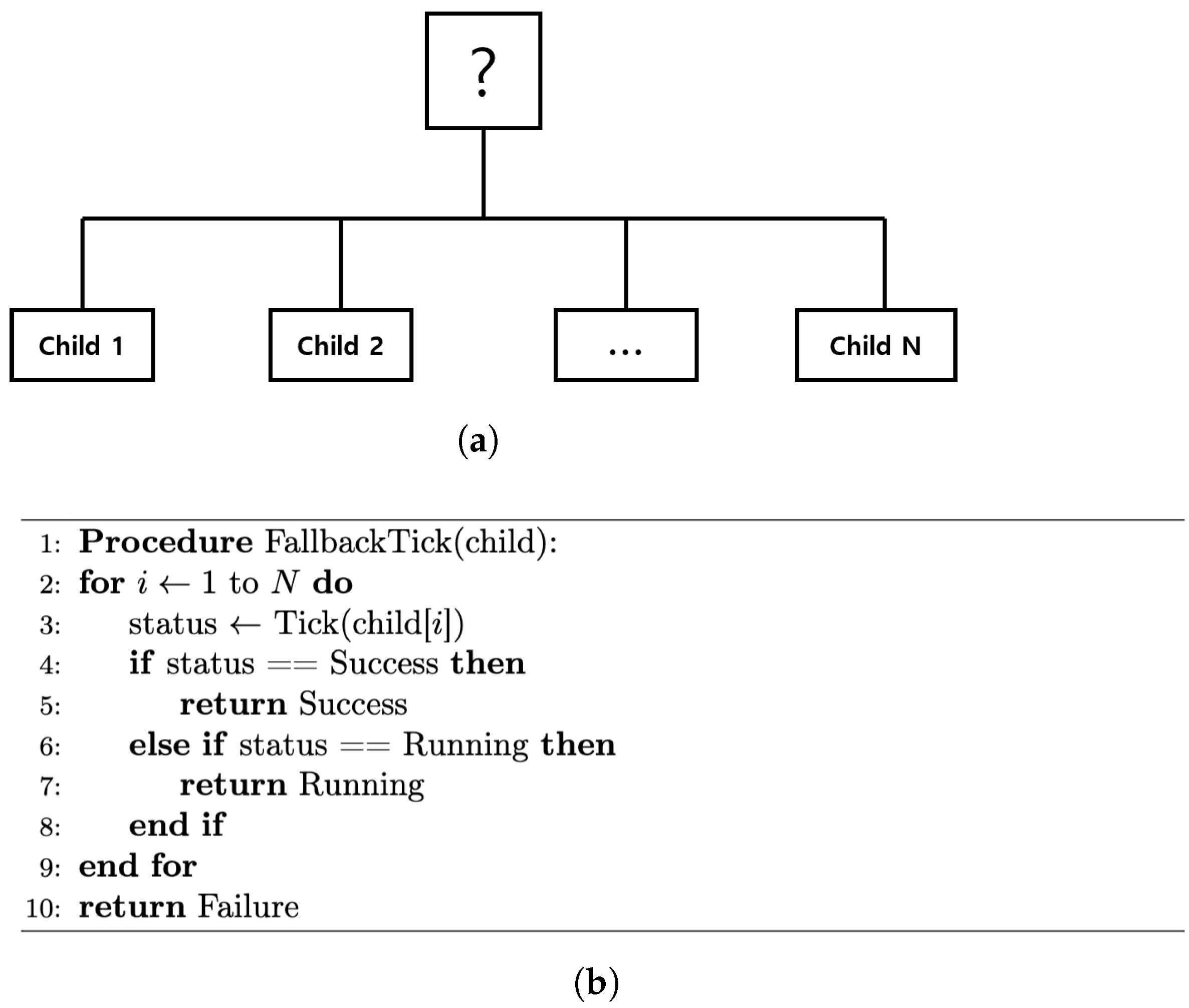



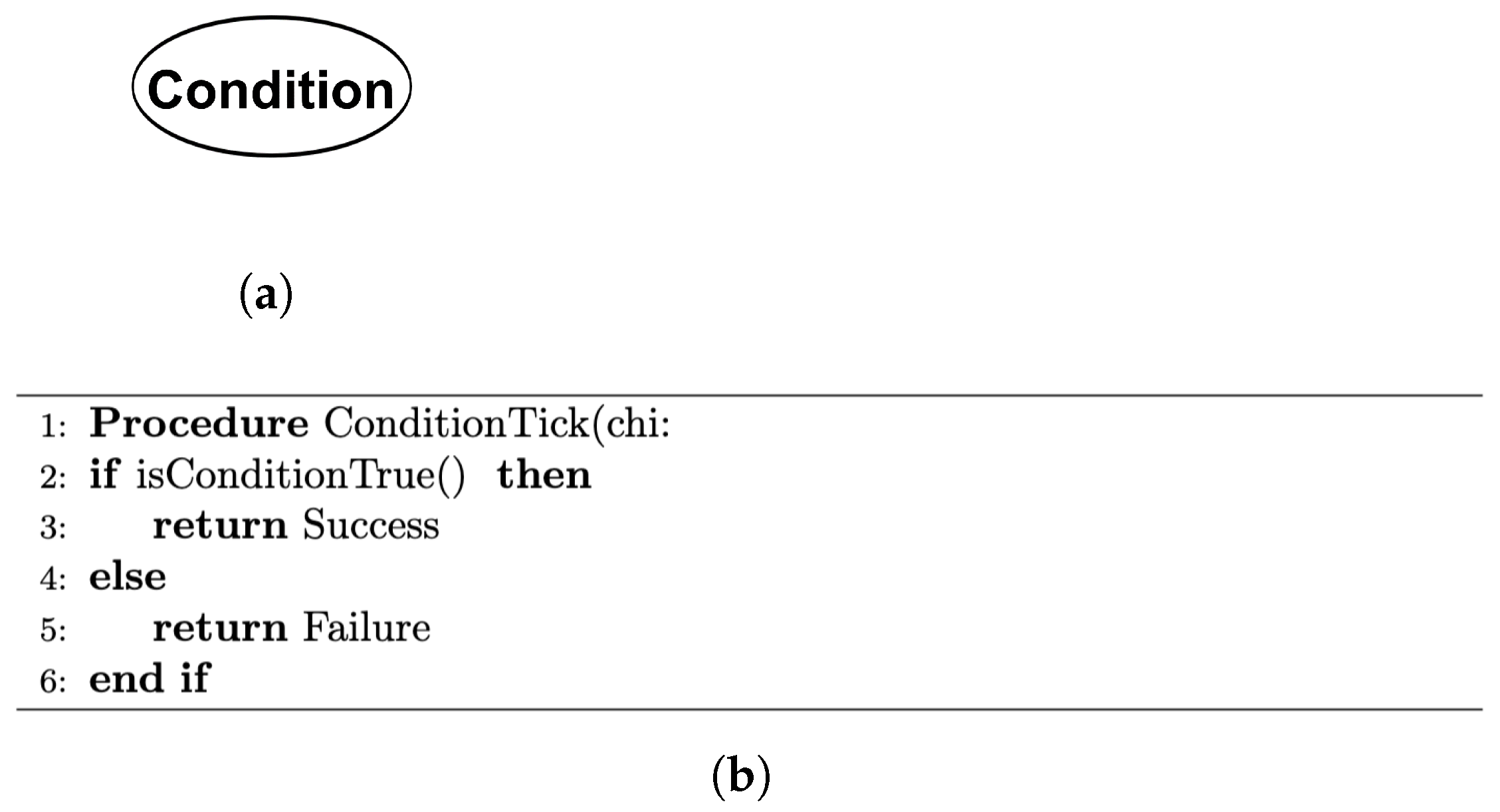
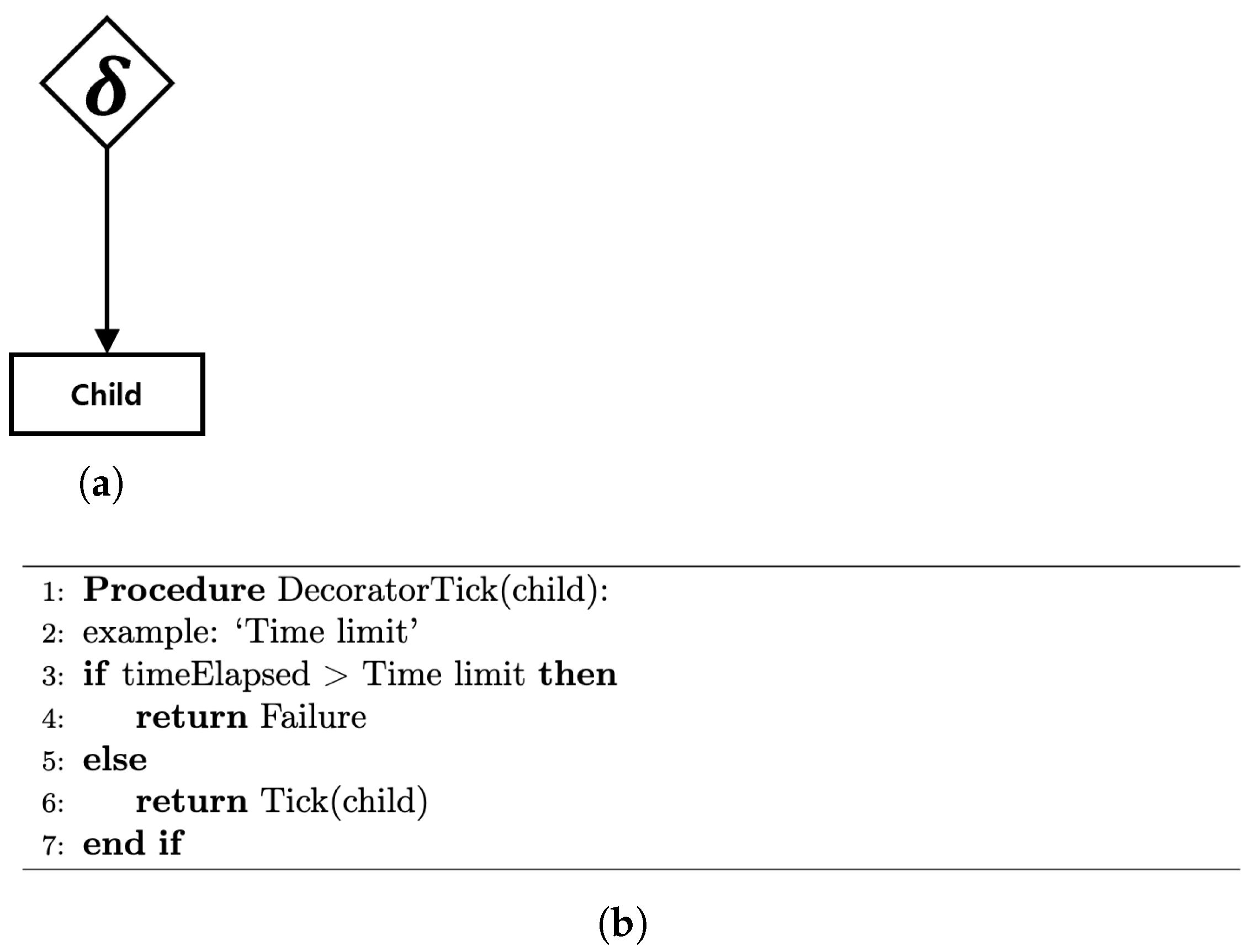

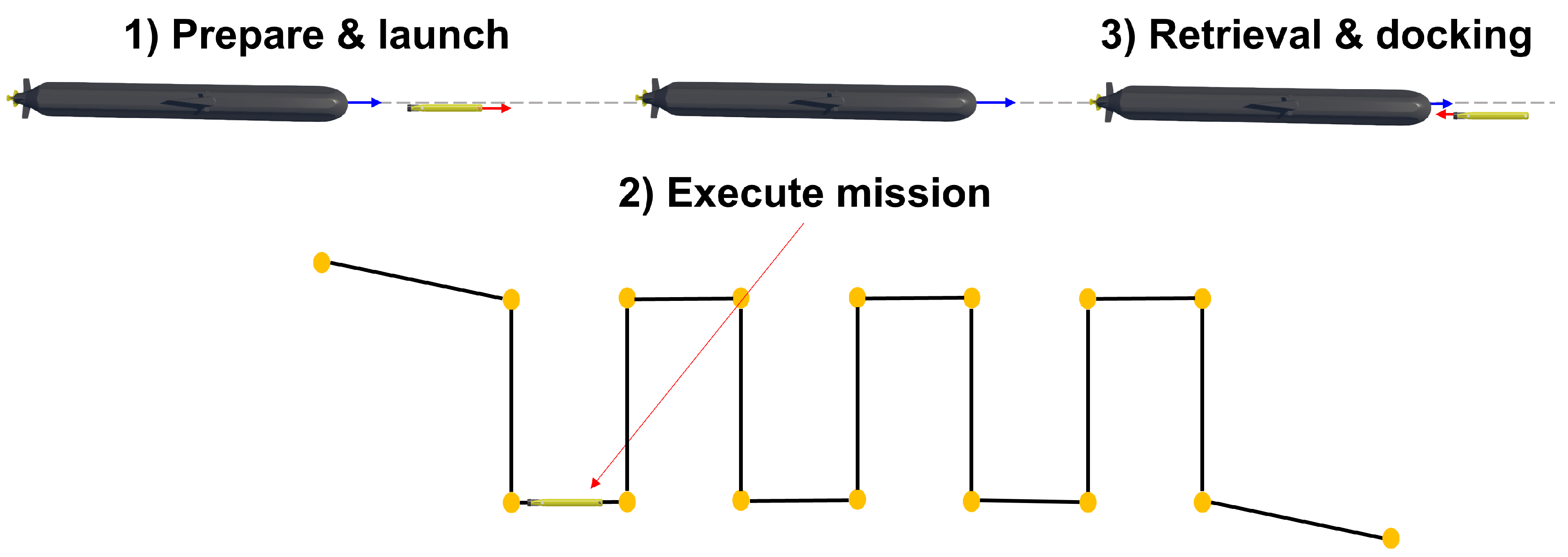

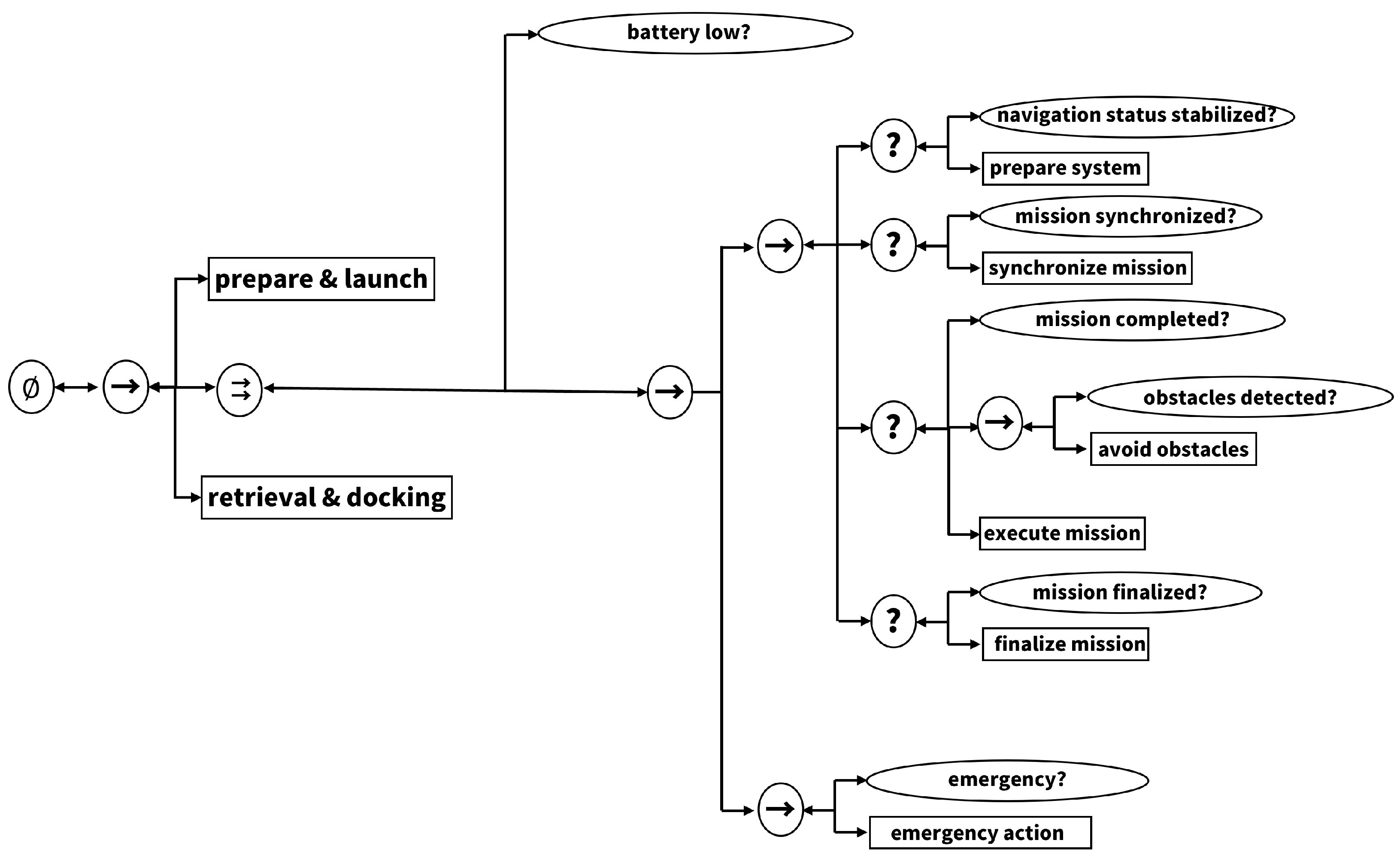
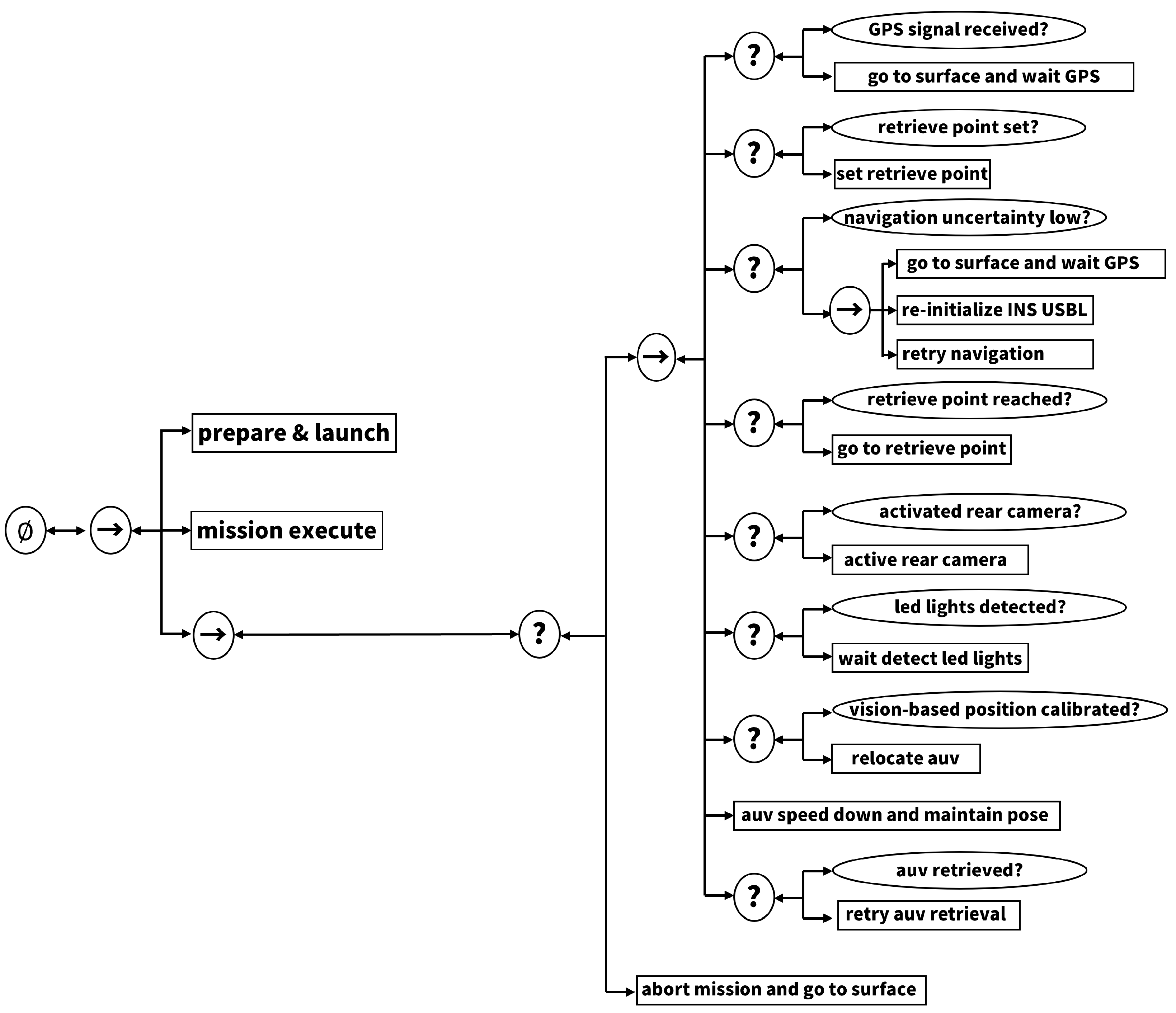
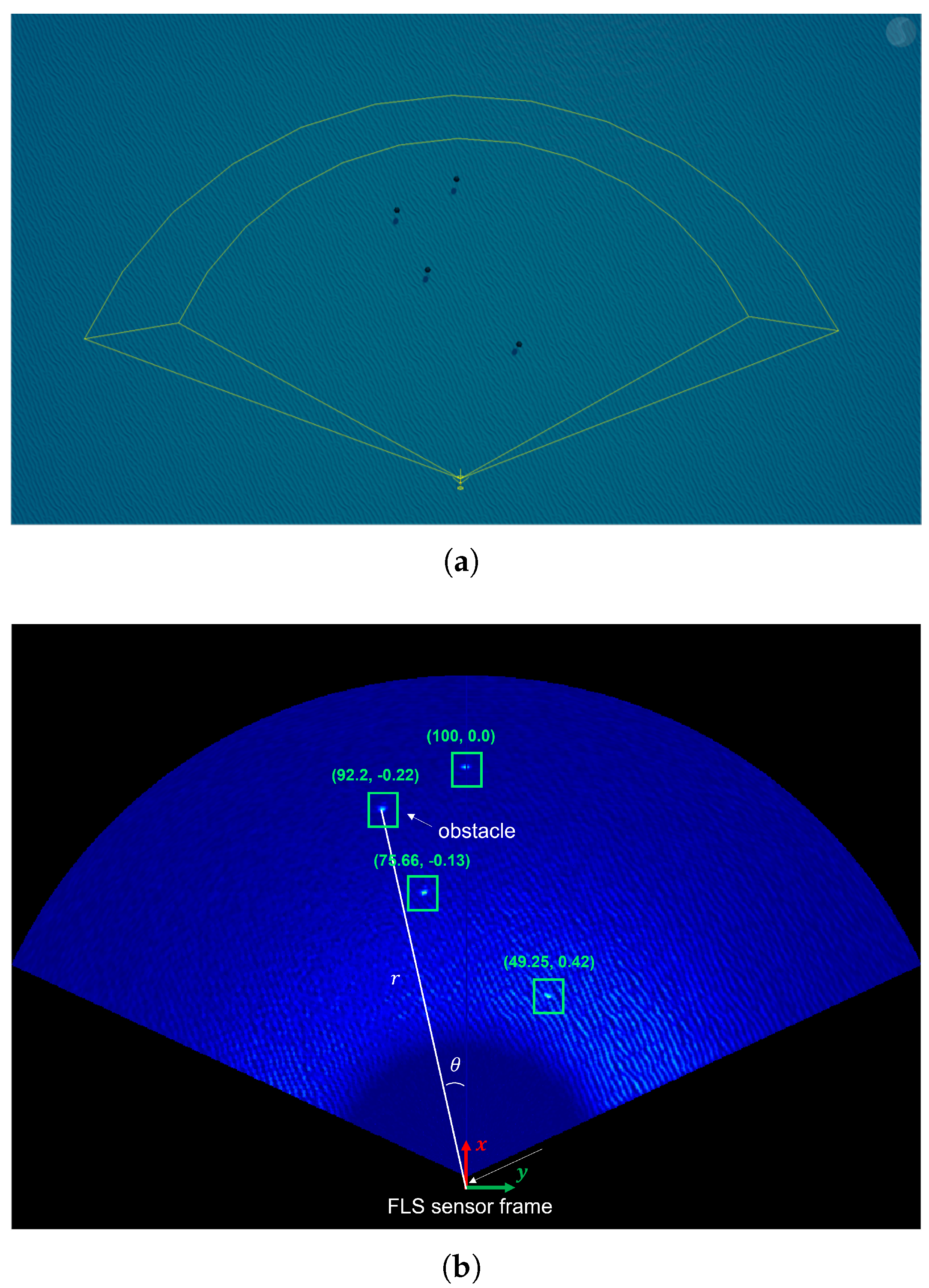

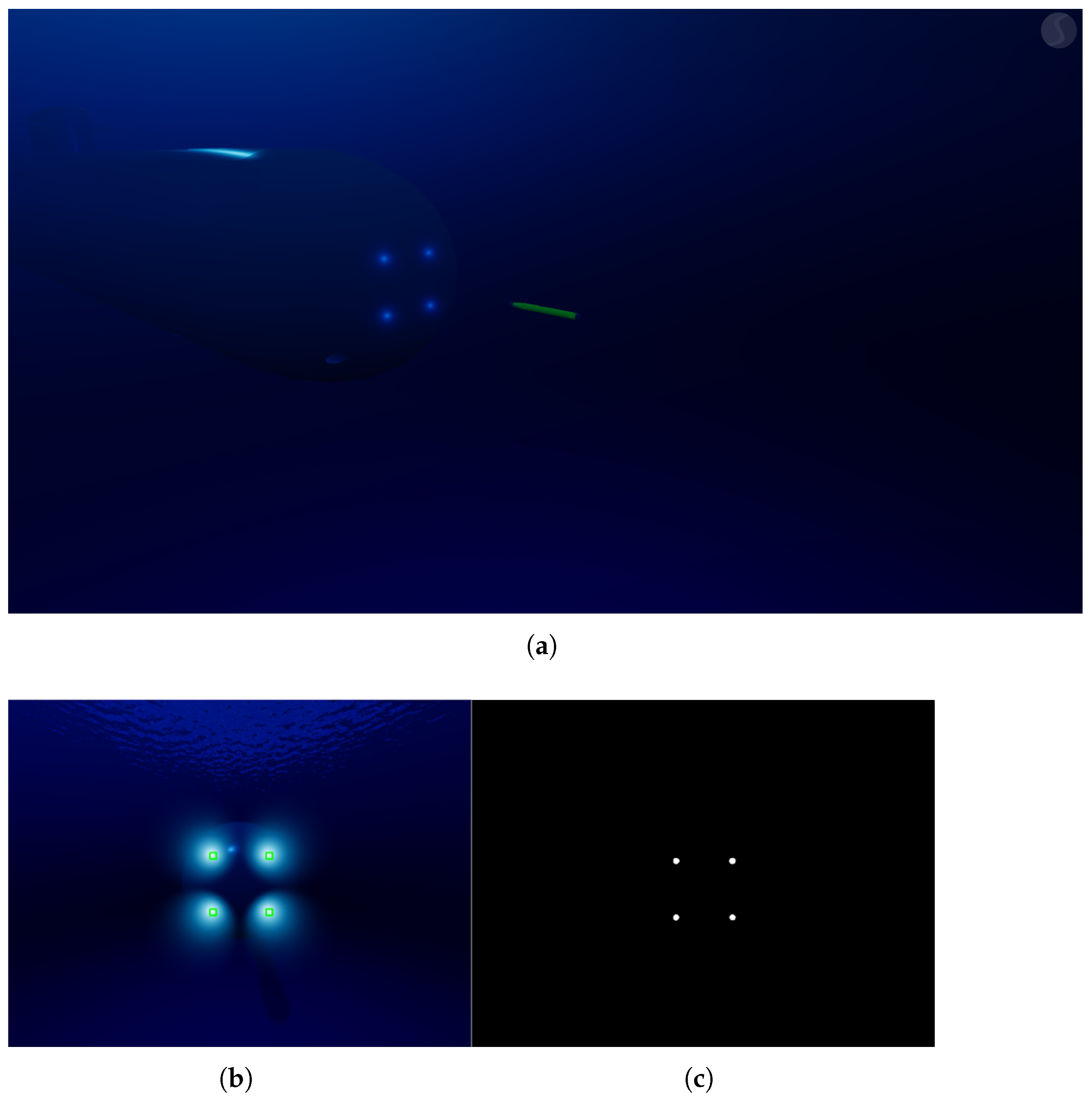
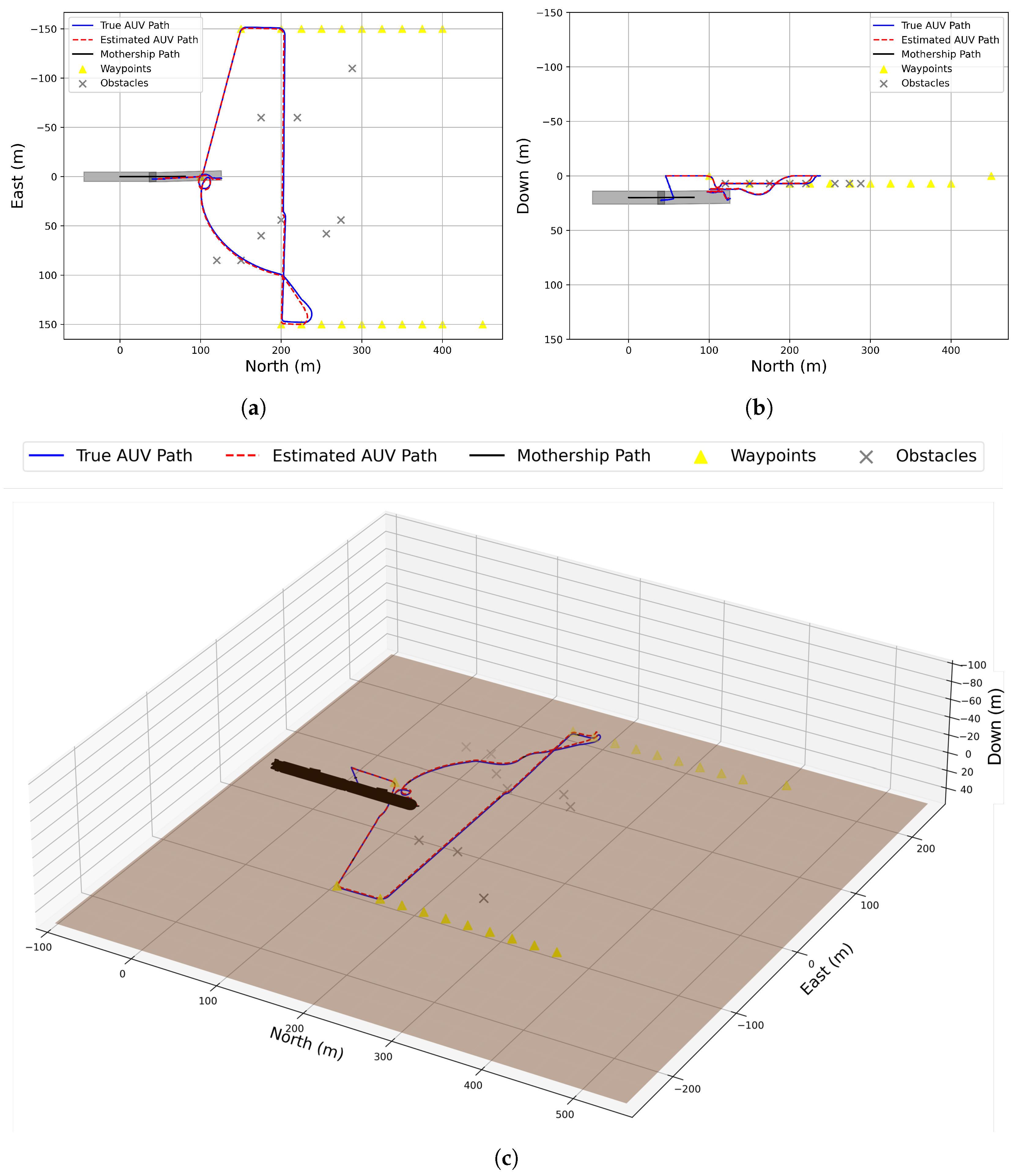
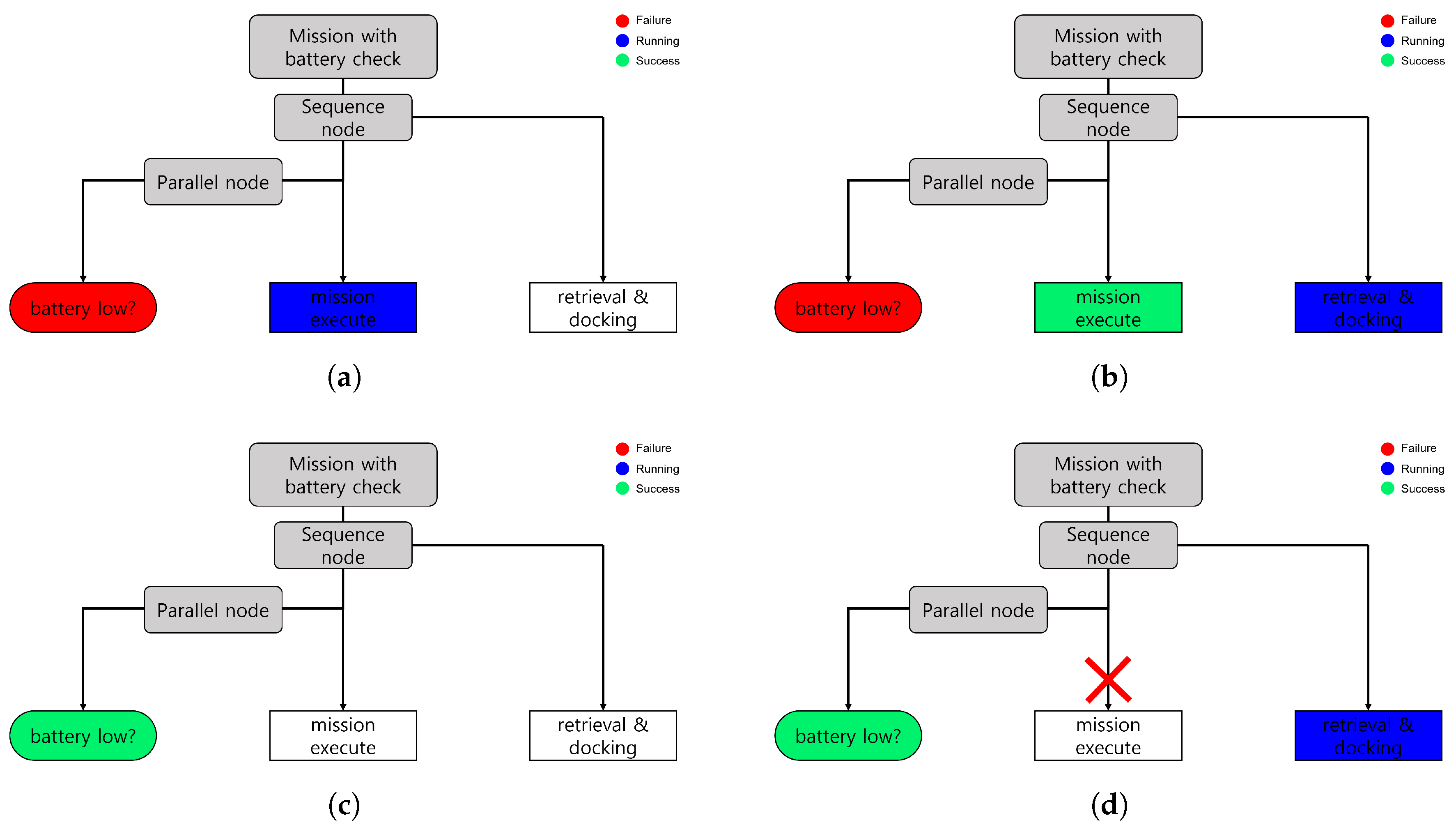
| Node | Symbol | Succeeds if | Fails if | Running if |
|---|---|---|---|---|
| Sequence |  | All children succeed | Any child fails | At least one child is Running |
| Fallback |  | One child succeeds | All children fail | At least one child is Running |
| Parallel |  | children succeed | children fail | Otherwise |
| Action |  | Action completes OK | Error encountered | Action still in progress |
| Condition |  | Predicate is true | Predicate is false | Never |
| Decorator |  | Custom rule | Custom rule | Custom rule |
| Safety Node | Parameter | Value/Threshold |
|---|---|---|
| Battery level | Min percentage | 30% |
| Abort & surface | Min altitude | 1.0 m |
| Max depth | 300.0 m | |
| Navigator time | Sensor timeout | 30 s |
| Internal temperature | Max temperature | Battery: 55 °C PC: 80 °C |
| Distance to mothership | Safe distance | 1000 m |
Disclaimer/Publisher’s Note: The statements, opinions and data contained in all publications are solely those of the individual author(s) and contributor(s) and not of MDPI and/or the editor(s). MDPI and/or the editor(s) disclaim responsibility for any injury to people or property resulting from any ideas, methods, instructions or products referred to in the content. |
© 2025 by the authors. Licensee MDPI, Basel, Switzerland. This article is an open access article distributed under the terms and conditions of the Creative Commons Attribution (CC BY) license (https://creativecommons.org/licenses/by/4.0/).
Share and Cite
Choi, S.; Jung, J. Dynamic Mission Planning Framework for Collaborative Underwater Operations Using Behavior Trees. J. Mar. Sci. Eng. 2025, 13, 1458. https://doi.org/10.3390/jmse13081458
Choi S, Jung J. Dynamic Mission Planning Framework for Collaborative Underwater Operations Using Behavior Trees. Journal of Marine Science and Engineering. 2025; 13(8):1458. https://doi.org/10.3390/jmse13081458
Chicago/Turabian StyleChoi, Seunghyuk, and Jongdae Jung. 2025. "Dynamic Mission Planning Framework for Collaborative Underwater Operations Using Behavior Trees" Journal of Marine Science and Engineering 13, no. 8: 1458. https://doi.org/10.3390/jmse13081458
APA StyleChoi, S., & Jung, J. (2025). Dynamic Mission Planning Framework for Collaborative Underwater Operations Using Behavior Trees. Journal of Marine Science and Engineering, 13(8), 1458. https://doi.org/10.3390/jmse13081458






